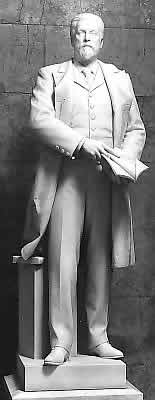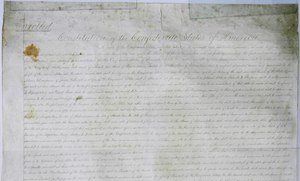Jabez Lamar Monroe Curry
Jabez Lamar Monroe Curry (June 5, 1825 – February 12, 1903) was an American Democratic politician and diplomat who served as an officer of the Confederate States Army in the American Civil War.
Jabez Lamar Monroe Curry | |
|---|---|
 Jabez Lamar Monroe Curry in 1901 | |
| Personal details | |
| Born | June 5, 1825 Lincoln County, Georgia |
| Died | February 12, 1903 (aged 77) Asheville, North Carolina |
| Nationality | American |
Biography

Curry was born in Lincoln County, Georgia, the son of Jabez and Rebecca Jordan Curry. His father, scion of a prominent Southern family, was cousin of Mirabeau Buonaparte Lamar, the second president of the Republic of Texas and husband of Tabitha Burwell Jordan, J.L.M. Curry's aunt. Curry grew up in Alabama and graduated from the University of Georgia in 1843 where he was a member of the Phi Kappa Literary Society. While studying at Harvard Law School, Curry was inspired by the lectures of Horace Mann and became an advocate of free universal education. He served in the Mexican–American War; in the Alabama State Legislature in 1847, 1853, and 1855; as a Democrat in the United States House of Representatives in 1857–1861; and in the Provisional Congress of the Confederate States. As a lieutenant-colonel in the Confederate Army, he was a staff aide to General Joseph E. Johnston and General Joseph Wheeler.[1]
After the war he studied for the ministry and became a preacher, but the focus of his work was free education in the South. He traveled and lectured in support of state normal schools, adequate rural schools, and a system of graded public schools. He was president of Howard College (now Samford University), Alabama from 1865–68, then a professor of history and literature at Richmond College, Virginia.[2] From 1881 until his death he was agent for the Peabody and Slater Funds to aide schools in the South and was instrumental in the founding of both the Southern Education Board and the first normal school in Virginia, now known as Longwood University.
Curry served as envoy extraordinary and minister plenipotentiary to Spain during 1885–1888 and as ambassador extraordinary to Spain on the coming of age of King Alfonso XIII in 1902. His publications include works on education, American government, and Spanish history. He was awarded the Royal Order of Charles III and several honorary degrees. Curry died on February 12, 1903, and is buried in Richmond, Virginia. His wife is buried in Talladega, Alabama, where their home, the J.L.M. Curry House, also called the Curry-Burt-Smelley House, still stands, a National Historic Landmark today.
Legacy
The Curry School of Education at the University of Virginia is named for him, in accordance with a stipulation in the 1905 donation from John D. Rockfeller, Sr. to fund the establishment of the school.[3]
In the Spring of 2020, the University of Virginia President Jim Ryan supported a recommendation that Curry's name be removed from its School of Education. The University's Board of Visitors will have the final decision on whether or not the name change will be accepted[4]. This reflects a shared effort on the part of the institution and the broader Charlottesville community to mitigate the stains of racism and slavery.
As 21st Century objections to Confederate tributes have become more widespread throughout the United States, Curry's legacy is worthy of careful scrutiny. His pro-slavery speeches from before the Civil War and membership in the Confederate House of Representatives demonstrate strong ties to the southern cause. However, his efforts to promote education for blacks during the Reconstruction era up through the end of the 19th century are reflective of ideals that were not shared by many of his contemporaries. In the same vein as Booker T. Washington, he promoted a more vocational style of education for blacks than he would for whites. [5]
Curry Hall dormitory at Longwood University and the Curry Building at the University of North Carolina at Greensboro are also named for him.
Until October 2009, Jabez Lamar Monroe Curry was honored by one of Alabama's two statues in the United States Capitol's National Statuary Hall Collection. It was donated in 1908 and sculpted by Dante Sodini. In October 2009, the statue was replaced with a statue of Helen Keller, and Curry's statue went to Samford University.[6] It was displayed in Samford's university center until the building was closed for renovation in 2018. At that point the statue was returned to the Alabama Department of Archives and History.[7]
Works
- Constitutional Government in Spain (1889)
- William Ewart Gladstone (1891)
- The Southern States of the American Union (1894)
- Difficulties, Complications, and Limitations Connected with the Education of the Negro (1895)
- Civil History of the Government of the Confederate States, with some Personal Reminiscences (1901)
References
- Bailey, Hugh C. "Jabez Lamar Monroe Curry". Encyclopedia of Alabama. Retrieved June 17, 2015.
- "Curry statue has new home on Samford campus". Samford University. Retrieved April 22, 2019.
- "Our History". Curry School of Education and Human Development | University of Virginia. July 27, 2017. Retrieved April 22, 2019.
- https://news.virginia.edu/content/curry-school-renaming-recommendation-referred-university-board-visitors
- https://news.virginia.edu/sites/default/files/report_of_the_naming_subcommittee_-_april_22_2020_.pdf
- Diel, Stan (November 25, 2009). "D.C. statue now at Samford University". AL.com. Retrieved April 22, 2019.
- Bains, David R. (July 9, 2019). "Remembering Jabez Curry and his Statue at Samford". Chasing Churches. Retrieved July 22, 2020.
External links
| Wikimedia Commons has media related to Jabez Lamar Monroe Curry. |
- NSHC biography
- The South in the Olden Time. Harrisburg, Pa.: Harrisburg Publishing Company, 1901.
- History of the University of Georgia by Thomas Walter Reed, Thomas Walter Reed, Imprint: Athens, Georgia : University of Georgia, ca. 1949

- United States Congress. "Jabez Lamar Monroe Curry (id: C001003)". Biographical Directory of the United States Congress.
- Jabez Lamar Monroe Curry at Encyclopedia Virginia
